JOUSTRA DIACLONE ROBOCOLT (BROWNING)
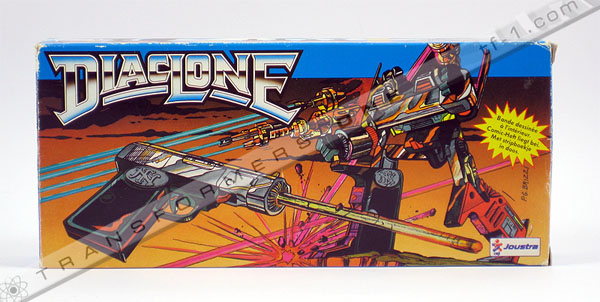
If you've had a chance to read the recently published Ceji Joustra Diaclone Overview article here on TF-1, then there's not a lot you won't already know about this European pre-Transformers toy line that ran between 1984 and 1985. For those that haven't familiarised themselves, French toy company Ceji released a selection of Takara's Diaclone and Micro Change Series toys in Europe branded as "Diaclone". The Ceji Joustra Diaclone "Robocolt" is from that first year of releases, and despite the whole range of Joustra Diaclones generally being incredibly stylish, attractive and well-presented items, the Robocolt 'Browning' from what collectors call 'Wave 1' oozes just a little more charm than his contemporaries.
Speaking of contemporaries, the 1984 Wave 1 assortment of Ceji Joustra Diaclone toys consisted of the Diaclone Truck (pre- Optimus Prime), Ambulance (pre-Ratchet), Ligier (pre-Mirage), Porsche 935 (pre-Jazz), Toyota 4x4 (pre-Trailbreaker), Caméra Robot (pre-Reflector), F15 (pre-Starscream), Multiforce 14 (GATS Blocker), Trans-Am (pre-Windcharger), Truck (pre-Huffer), Pick Up (pre-Gears), Cheetah (pre-Brawn), Condor (pre-Laserbeak), Jaguar (pre-Ravage), Aragon, Cromar and Zetar (pre-Powerdashers), Turbo2000, Cheetah (again), Van (Change Attack Cars), Kronoform (Watch Robo), Diatrain, Cosmo Car (Cosmo Roller) and of course Robocolt.
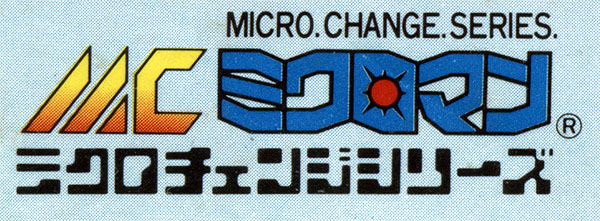
We've mentioned Takara's Micro Change Series, so before we delve into the specifics of the Joustra Diaclone Robocolt, let's just have a look back at its roots. In 1981 Takara launched New Microman in Japan, and 1983's sub-category Micro Change Series was supposed to be a 1:1 scale range of interesting but reasonably common technical items such as guns, cassette players, micro cassettes, watches etc that transformed into robots. Amongst these was the MC-07 Gun Robo M1910 Browning.
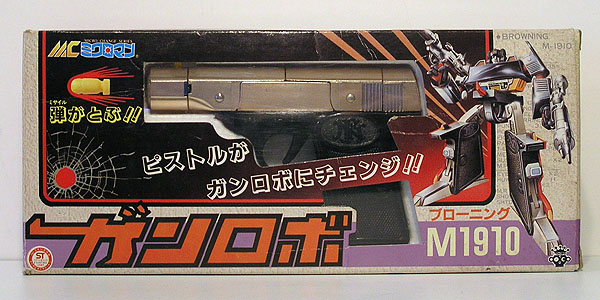
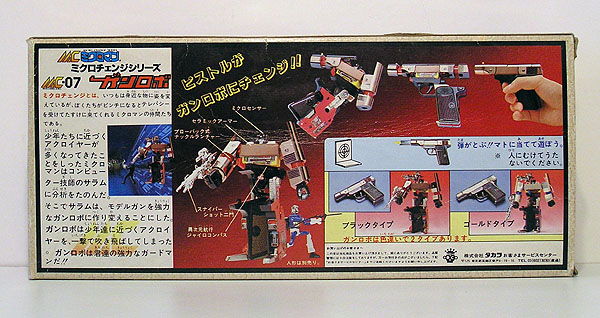
Put yourself in the shoes of an early 1980s toy collector or child, and you can begin to imagine just how much of a revelation the items from this Micro Change Series, especially the Browning Gun Robo, would have been. The MC-07 Gun Robo M1910 Browning is specifically based on John M. Browning's 1910 real life firearm produced by Fabrique Nationale of Belgium. Here is an image of the actual M1910 model:
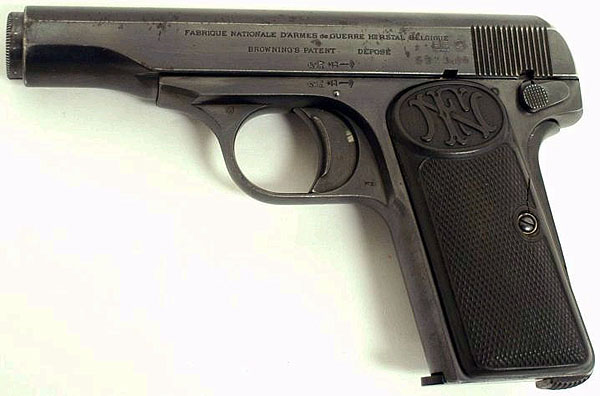
This toy was available in two main types, a dark smokey chrome version with red outer legs and innards, and a more matte-like chrome with a slight rose gold tint and blue outer legs and highlights. Here they both are in their insert packaging, complete with firing bullets on sprue, chromed handguns and paperwork:
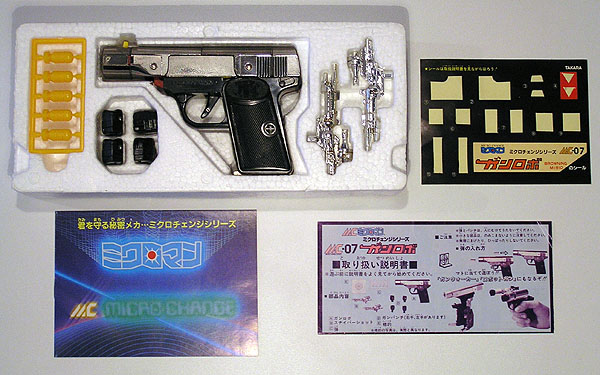
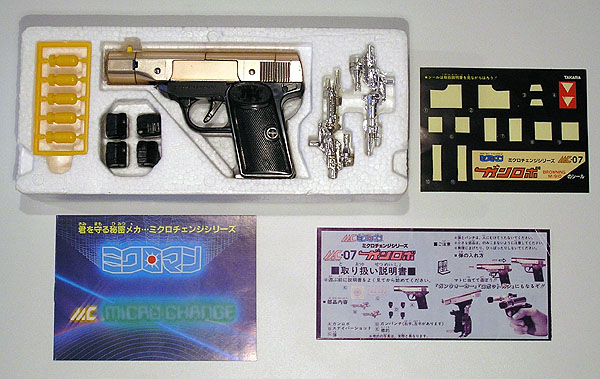
The difference in chrome shading (dark and smokey with red versus pink-tinted gold and blue) is not entirely clear in the above comparison shots, so here's a slightly better image of the two MC-07 Browning types together in gun mode:
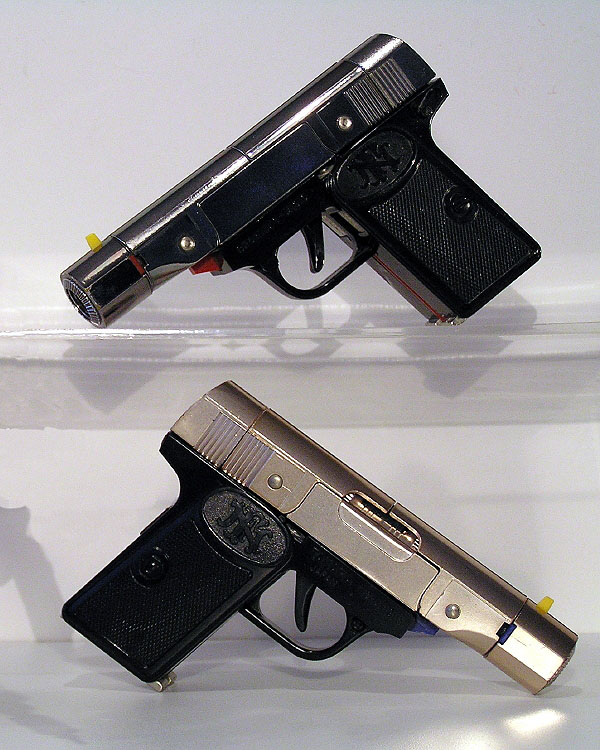
No digital image I have seen so far brings out the quite amazing effects on the chrome of both versions of this toy. They simply must be seen in person and held side-by-side for the full effect to be appreciated.
An all-gold chromed MC-07 Gun Robo Browning was also available in Japan as a campaign prize item, not unlike the Diaclone gold chromed Car Robots. There are 3 known examples of the gold Browning, and they come in standard MC-07 packaging with mostly the same paperwork shown above. Here is a scan from the Takara SF Land book:
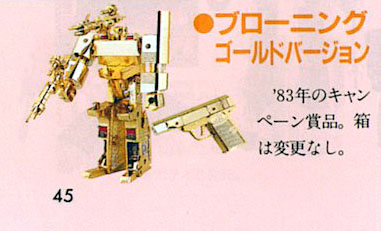
MC-07 Browning was also available in Italy as part of their selection of Micro Change Series toys, distributed and released by GiG. The Italian Browning had red paint on the end of the barrel due to safety laws, clearly marking the item out as a plaything and not a genuine firearm. The GiG release of Browning is certainly much rarer than its Japanese mass released counterparts, and apparently available in both main colours. You can see below that on the back of the box it says "Tipo nero" and "Tipo oro" which translates as "Black type" and "Gold type" respectively, in reference to the chrome more than the plastic colour. The GiG version also has some interesting Micro Change artwork on the back in the bottom left corner of the box showing Browning and micro cassettes, and it's not the last time that Browning and Micro Cassette Condor will meet...
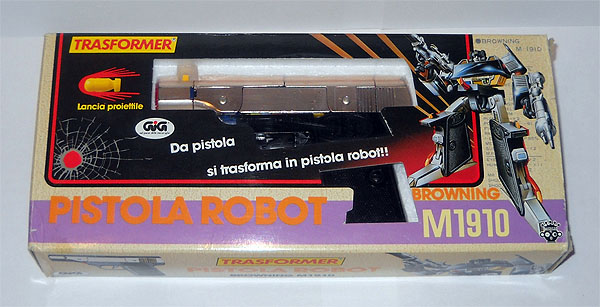
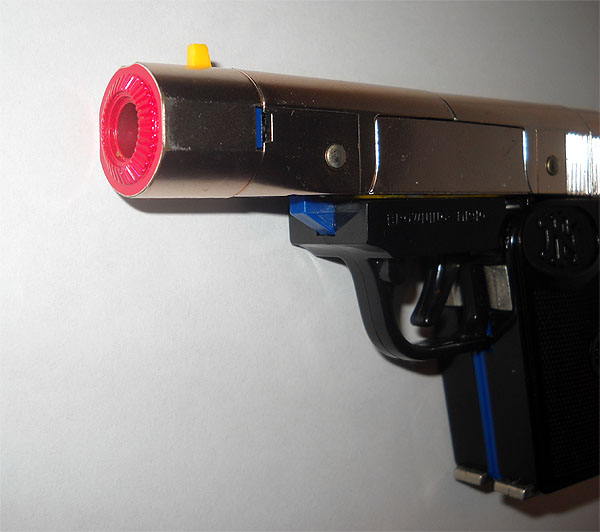
The Micro Change Series Browning was also, incredibly, available in Finland as part of Takara's truly obscure little branch of releases in that country. Covered mostly in English text such as "Microman" and "Gunrobot", it is terribly easily to overlook the Finnish Browning as a knockoff, but it is a genuine Takara product of insane rarity, and it also comes in smokey chrome & red plus rose gold chrome & blue.
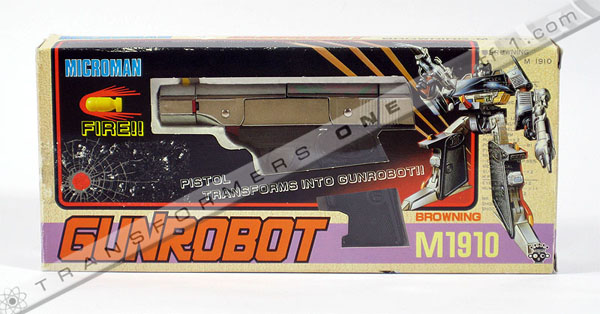
Unlike the Walther P38 Gun Robo that became the Transformers "Megatron", the Browning mould was never used by Hasbro for their Transformers range in North America and Europe. Takara however released Browning again as a Destron (Decepticon) for their 1988 Transformers: Super God Masterforce (Chōjin Masterforce) series.
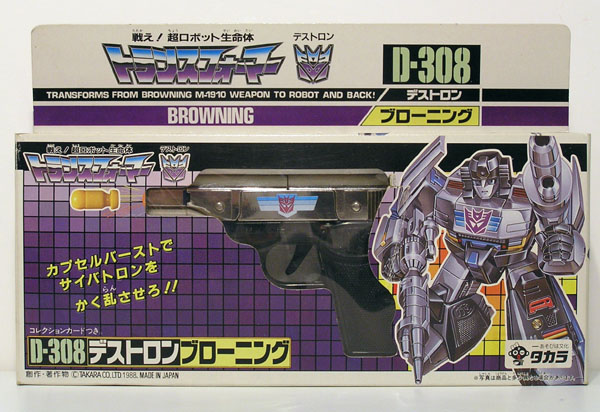
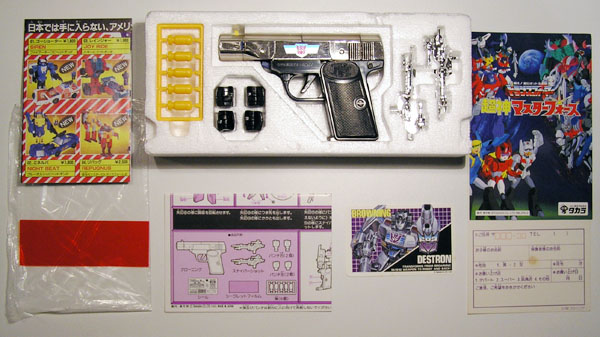
The D-308 Transformers Browning had a different stickersheet and artwork than the original Micro Change MC-07, but the same styro layout. The toy itself is shiny silver chrome and blue, with a very fetching Decepticon insignia on his chest and a host of accompanying paperwork.
Now, North America did receive this toy after a fashion, but it was not an official release. A number of bootleg versions of the MC-07 M1910 Browning were released in similar packaging, all chromed up just like the original, but with noticeable differences:
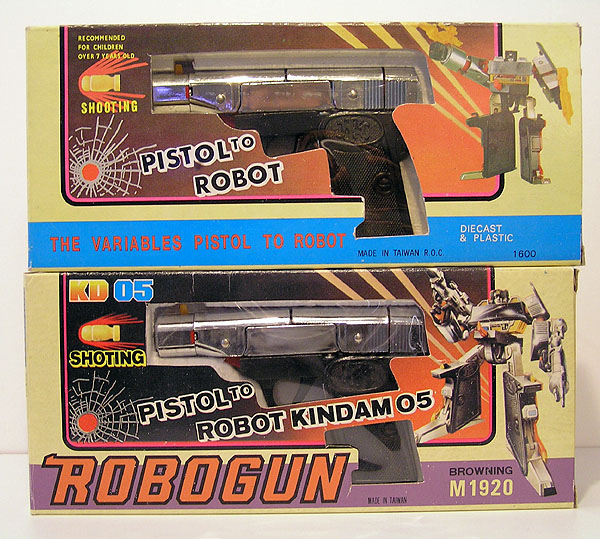
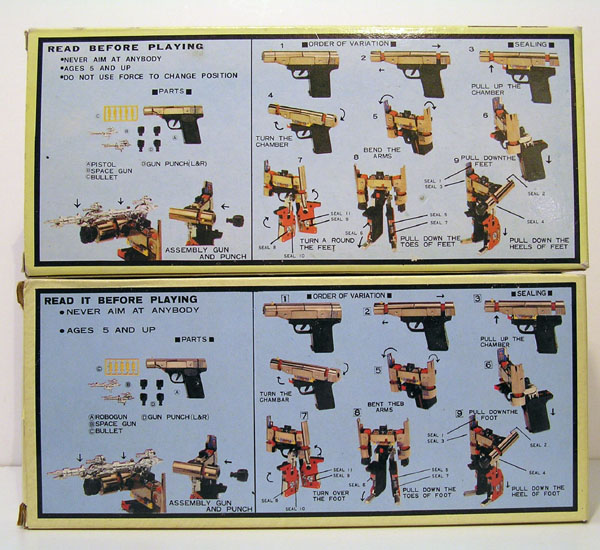
These Taiwan remakes, one of which was labelled as "Kindam (sic) KD05 M1920" with the same artwork, had a similar overall box design, and another with a slight departure from the original featuring only photography and less MC-based logos.
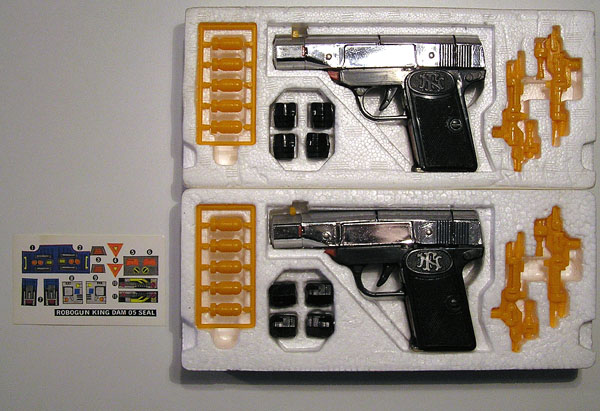
You can see both bootleg versions shown here have un-chromed guns and the bullets are a little more orange than yellow. The stickersheets are also white instead of black. I'm yet to see a blue variant of a KO Browning, so far I have found only red editions.
So, the fact that only Japan, Finland and Italy had this mould officially as Micro Change and Japan had it solely again as a Masterforce Transformers item, the few European countries that received this exquisite toy as a Ceji Joustra Diaclone release should count themselves lucky, especially considering the superior presentation of the Joustra Diaclone edition.
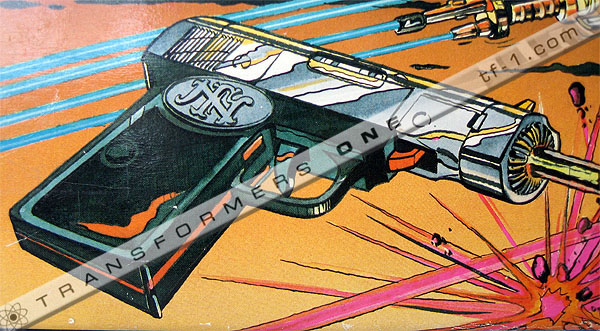
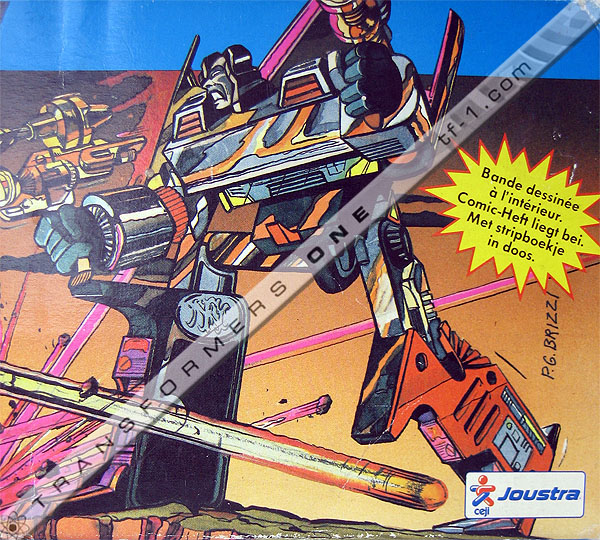
This insanely dynamic and fierce artwork by Paul and Gaetan Brizzi for Ceji Joustra's release of Browning elevates this particular version of the toy above all other Gun Robos, never mind Brownings. It radiates character, style and really makes you feel that a huge amount of effort has gone into making this item unique among its predecessors and ancestors. It's not as if the art was used to mask some massive deficiency with the product itself either. We already know how amazing the contents are, and that's to say nothing of the Joustra exclusive mini-comic that accompanies this release, advertised clearly on the box front in the yellow action bubble. There's so much gorgeous detailing in that artwork, from the "FN" logo on his inner legs to the correct mould detailing on the diecast leg and chrome barrel sections. And even though the artists have depicted their own expression of his character in Robocolt's face and pose, the beauty of this art is in its honesty, because truly it is a marvellous representation of the toy and its capabilities.
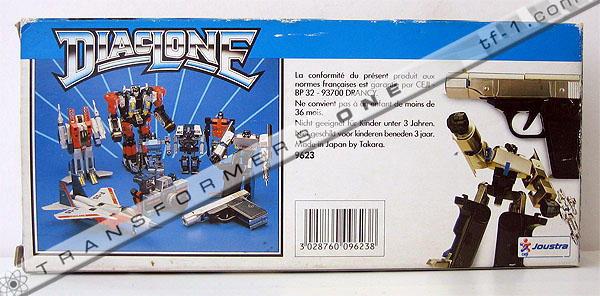
The box back allows us to catch our breath again after the intensity of the artwork on the front of the package. Despite the fact that the artwork shows the red variant of the mould, all the stock photography across the packaging and in catalogues shows the blue Robocolt variant. As is typical for Wave 1, Robocolt is banded together with Caméra Robot, F15 and Multiforce14. This is a very interesting insight into the development process for the Ceji Joustra Diaclone backstory as these toys are not really related in this universe. We know that Multiforce14 is the main villain of the Ceji Joustra "Duel Sur Diaclona" story, but Caméra Robot and F15 are on the side of good. Also, all 4 of these items were not originally Micro Change toys, F15 and Multiforce14 were Diaclone designs. So what's the connection? To quote directly from the Overview article:
"The only tie these toys have together is the fact that they were depicted as evil characters in The Transformers (Starscream/Thundercracker, Reflector and a different gun robo: Megatron)... Since this stock photography would have been done in the early stages of the line (hence the use of Japanese MC and Diaclone toys), the plan for the War On Diaclona story might have been different back then, with the good and evil factions not yet finalised."


Now usually the Wave 1 Joustra packaging for each toy has some humorous error, mis-transformation or oversight and what barely passes for instructions on the less visible parts of the packaging like the top, bottom and sides, but Robocolt has no such mistakes. The toy is shown with all the correct accessories and even the right number of bullets. He is not mis-transformed or holding someone else's handgun, all I can spot is that he has not had his stickersheet labels applied and his robot mode image is mirrored on the box top (you can tell because his barrel arm is suddenly his left arm instead of his right). Good work Ceji!
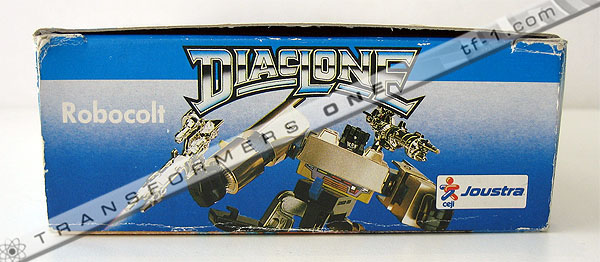
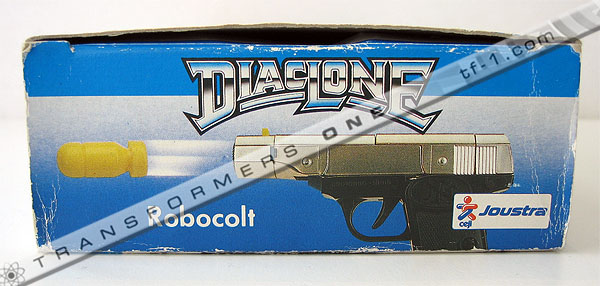
There's not a lot wrong on the sides of the box either, he is even shown wearing one of his handguns as a shoulder weapon, which is one of the original intended configurations for the mould. The packaging has a very blue theme to it thanks to the blue highlights on the photographed Browning, the background gradient and the blue sub-category stripe that runs along the top of all the sides of the box. That blue sub-category stripe is shared by all the Wave 1 toys shown in the group shot on the back of Robocolt's packaging.
You may be asking yourself why he is called "Robocolt", when all the other Joustra Wave 1 items are typically named after the item or brand they represent, such as "F15", "Porsche 935", "Ligier", "Toyota", "Trans-Am" and so on. Why wasn't he just called "Browning" as he generally is everywhere else? My theory on this is that previous to the M1910, Browning's designs were released in the US by Colt Firearms in addition to Fabrique Nationale (FN) in Europe. The name "Robocolt" could be a literal description of his function, a robot version of a Colt firearm. The irony of this is that the M1910 was one of the designs that Colt Firearms did not decide to produce for the American market. Maybe "Robobrowning" just didn't have a good enough ring to it...
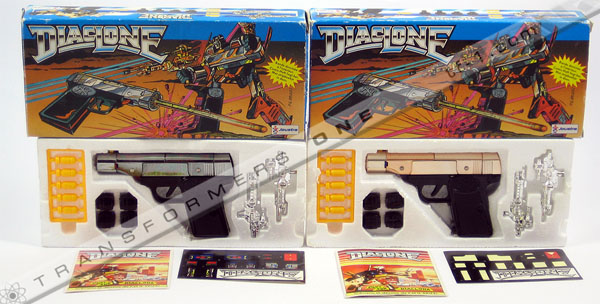
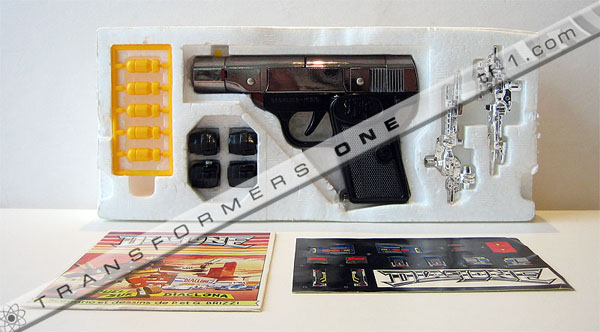
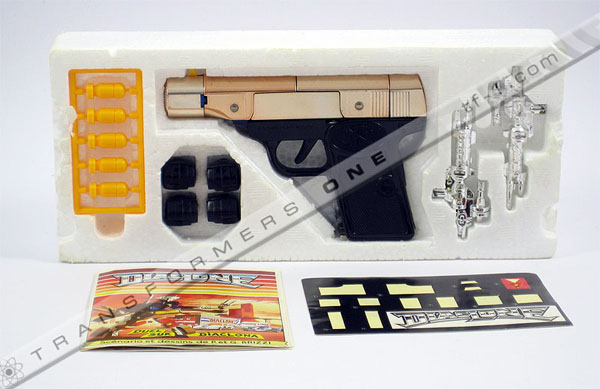
The Ceji Joustra Robocolt, like the Japanese MC-07 Browning, was released in both red with smokey chrome and blue with matte rose gold chrome variants with the red being noticeably less common than the blue. It is not a country-specific thing however as red variants have been found in France and the Netherlands. As Robocolt is from Wave 1, he comes with a chapter of the "Duel Sur Diaclona (War On Diaclona)" mini-comic exclusive to Ceji Joustra Diaclone toys and a stickersheet with some unique details. The styro as well as the toy and accessories are the same as those found in the MC-07 package.
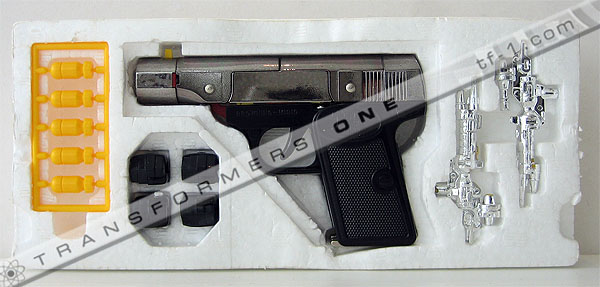
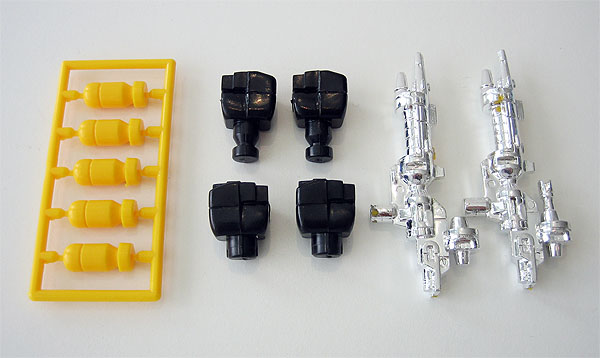
The version I will be covering in most detail in this article is the smokey chrome release with the red outer legs and details, and unfortunately you may notice that one of the handguns has a small broken scope section. If you can stomach those limitations, we shall continue! On the subject of accessories, notice that Robocolt comes with 4 fists (2 left and 2 right). The right-sided fists attach to the end of the barrel in robot mode and as a result they benefit from the firing mechanism, hence the slightly re-tooled tabs on those fists to enable projectile use.
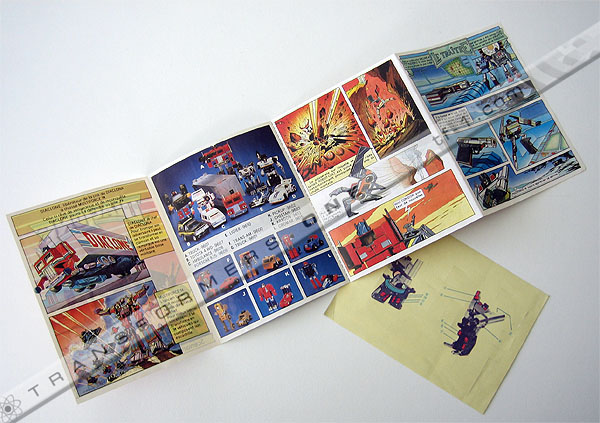
Robocolt's paperwork is also of special interest. By now you may be well aware that Wave 1 Joustra Diaclones have lovely exclusive mini-comics featuring familiar characters in unfamiliar roles and situations that double up as small product catalogues. You may also know that Joustra Diaclone stickersheets contain the Joustra "Diaclone" logo instead of original Japanese logos and a placement map on the back. Robocolt is a little different to the rest though, as hinted at in the above picture.
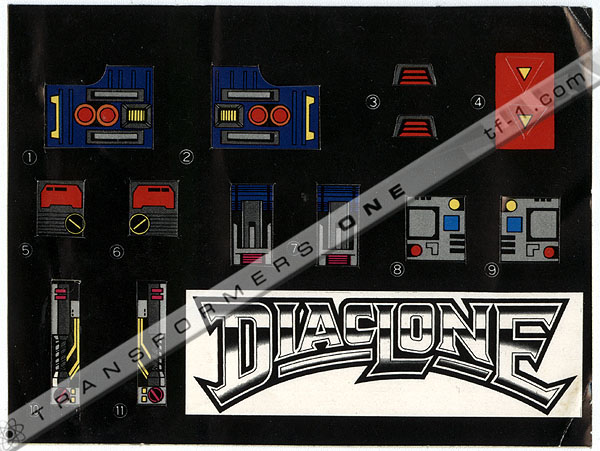
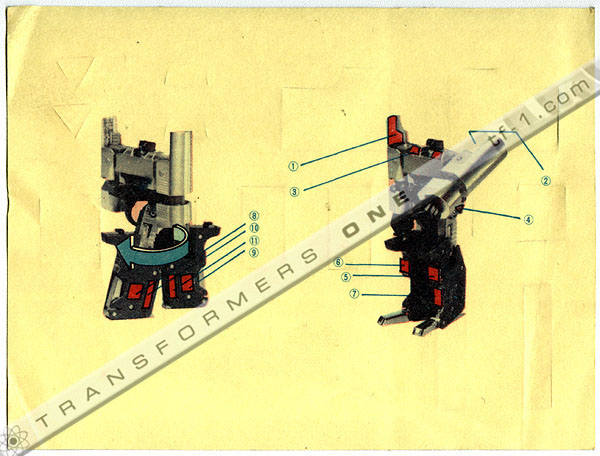
Most Joustra Diaclones have sticker placement maps on the back of their stickersheets as mentioned above, the known exceptions being Cosmocar, Diatrain, Cassette Moto and Cassette Helicoptere which have a separate map included. Of all those placement maps I have seen, Robocolt, on the back of his stickersheet, is the only one I've found featuring a photograph with colour instead of a line-art style diagram. Incidentally it is the blue variant photographed again. So why is this the case? Simple, Ceji Joustra or Takara lifted these images directly from the Japanese Micro Change Series MC-07 Browning instruction sheet where colour and photography is used. You can tell because on the left-hand image there is a small pink section where the figure's trigger/crotch is, and of course the Japanese instruction sheet has a pink background. There are no instruction sheets or booklets included with Joustra Diaclone toys.
I feel your anticipation growing ahead of another series of exclusive Joustra comic scans, but there's something worth mentioning here thanks to a recent discovery. So far, all Robocolts have been found with Chapter 8 of the 10-piece mini-comic "Duel Sur Diaclona". It is widely believed that the comic chapter included with any given Joustra Diaclone corresponds to that toy's part in the story, or at least to begin with they were packaged that way. Typically the carded items were not released with mini-comic chapters, so their artwork is featured alongside another character in a particular chapter. Also, it is common for two releases to share the same comic, such as Porsche 935 and Ligier, Ambulance and Cosmocar or Diaclone Truck and Toyota.
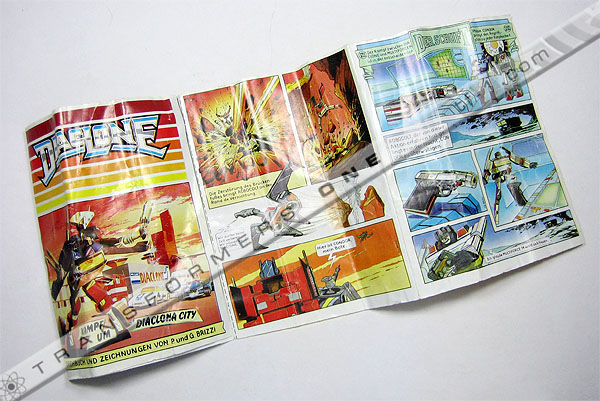
Some, however, only came with one toy originally. It was believed that chapter 8 was totally exclusive to Robocolt as he is the main protagonist in this segment of the tale along with one other carded toy. Recently though, chapter 8 was found with a Toyota 4x4 in Holland, and while this could just be a result of old childhood mix-ups it was very interesting that this chapter 8 of "Duel Sur Diaclona", or in this case "Kampf Um Diaclona City", was the first one ever found in German. All previous chapter 8's were in French regardless of what country the toy originated from. Chapters 1, 4, 6 and 9 have also been found in French and German, chapter 5 has exclusively been found in German so far.
I digress though, here is chapter 8 of "Duel Sur Diaclona" scanned in French with the now-customary shoddy translation from the German version in red and from the French in blue:
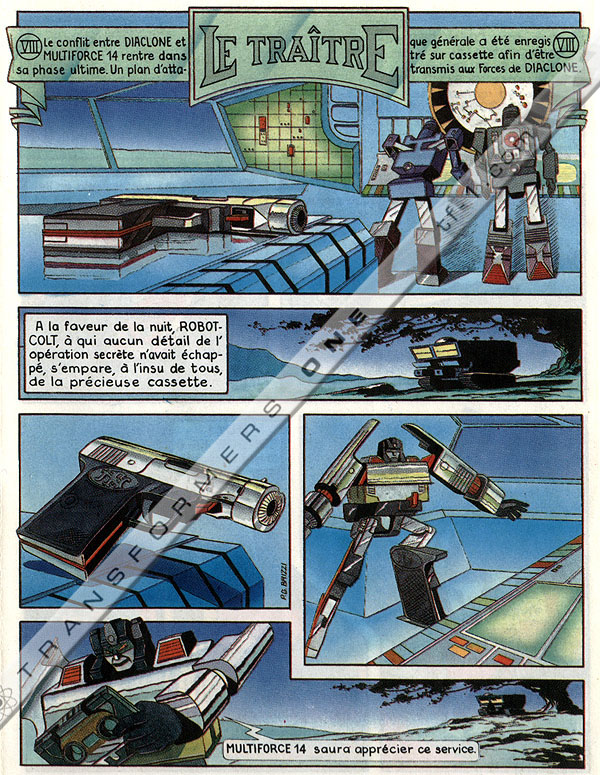
"Chapter 8: Villain - The battle between DIACLONE and MULTIFORCE 14 is in a crucial phase. CONDOR brings the plans to attack each combat unit"
"Chapter 8: Traitor - The conflict between DIACLONE and MULTIFORCE14 enters its final phase. A general plan of attack was recorded on tape to be sent to the forces of DIACLONE"
"ROBOCOLT who learned of this action succeeded in overpowering CONDOR in the night"
"Under the cover of night, ROBOT-COLT, to whom no detail of the secret operation had escaped, seizes, unknown to all, the precious tape."
Robocolt: "I think MULTIFORCE 14 will rejoice."
Robocolt: "MULTIFORCE14 will appreciate this service."
Oh there's so much good stuff here, where to begin! First of all let's place this chapter chronologically; F15 and Caméra Robot discovered Multiforce14's base, were attacked and found refuge but F15 was hurt. Ambulance and Cosmocar came to their aid and decided to forward the secret plans and discoveries to Diaclone. That's where we find Robocolt lying on a table unnoticed, much like Decepticon communications officer Soundwave used to spy on Autobots. If Ceji Joustra were unsuccessful in licensing the Cassette Man mould from Takara, they have clearly used Robocolt as his spy replacement. Once again we see Cosmocar and the pre-Reflector in the story, cementing their roles as main characters.
Another interesting fact here is that the French comic refers to Robocolt as "Robot-Colt", but the German comic uses the correct "Robocolt" designation. This could be a result of the French comic possibly being written and printed earlier than the German version. We can see Robocolt's gun mode box artwork on this page, minus firing bullets. Also, he is clearly based on the red Robocolt variant.
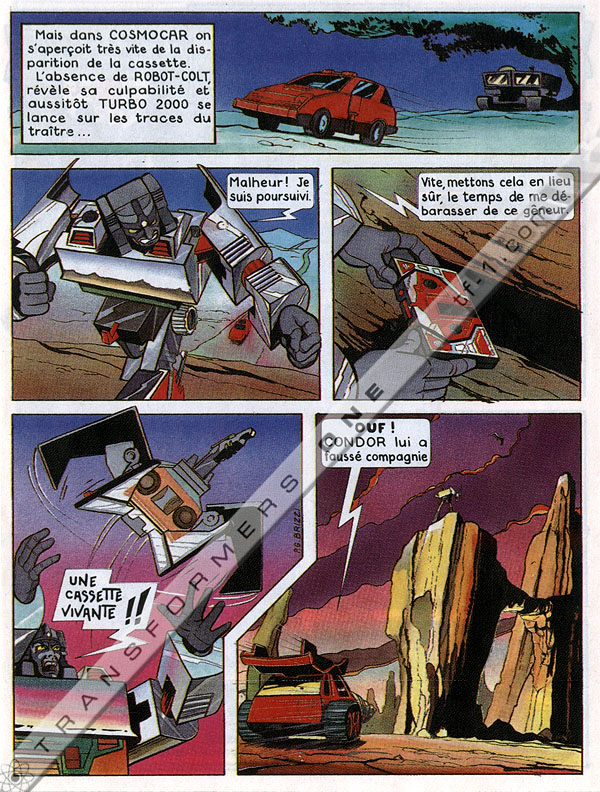
"The kidnapping of CONDOR is noticed in COSMOCAR quickly. ROBOCOLT is immediately under suspicion and TURBO2000 takes up the hunt."
"But on COSMOCAR, the disappearance of the cassette becomes evident very quickly. The absence of ROBOT-COLT reveals his guilt and soon TURBO2000 sets off in the footsteps of the traitor."
Robocolt: "They pursue me!"
Robocolt: "Misfortune! I am being pursued."
Robocolt: "We must disappear, CONDOR must be hidden in a safe place."
Robocolt: "Quick, hide in this place, we must get rid of this nuisance."
Robocolt: "He is a living cassette!"
Robocolt: "A living cassette!"
Turbo2000: "So! CONDOR is safe..."
Turbo2000: "Whew! CONDOR has parted company."
There is an implication in the story, not only from the chapter title, that Robocolt in fact betrays the Diaclone forces in kidnapping Condor. This is somewhat contradicted by his surprise that Condor is in fact...a Condor, and not just a data cassette.
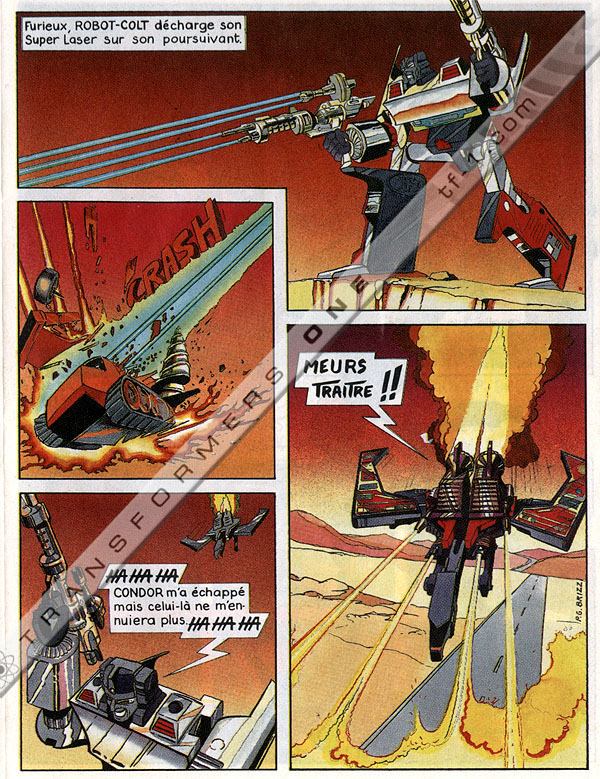
"Angry, ROBOCOLT tries to shoot at his enemy with his Superlaser."
"Furious, ROBOT-COLT discharged his Super Laser at his pursuer."
Robocolt: "HA HA HA! CONDOR escapes, but you I have!"
Robocolt: "HA HA HA CONDOR escaped me, but this one won't bother me anymore. HA HA HA"
Condor: "Now it is over, villain!"
Condor: "DIE TRAITOR!!"
Turbo2000 gets a shot right in the face and appears done for and Condor is a good guy! Transformers it is not. In this page alone we can see Robocolt's robot mode box artwork in much less detail (like Joustra pre-Optimus in chapter 10) and Condor's card artwork too. This lends weight to the theory that carded toys did not come with comics, but instead had their artwork featured in other chapters.
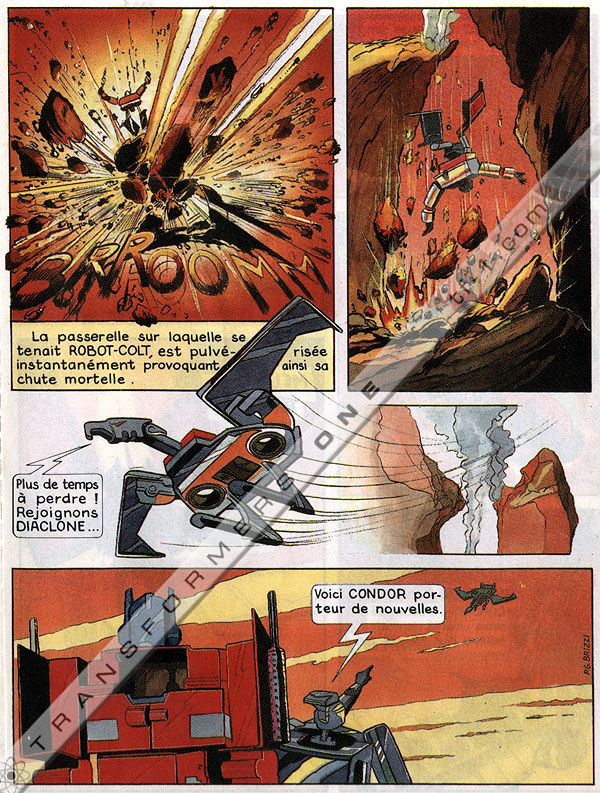
"The destruction of the footbridge brings ROBOCOLT to the edge of destruction."
"The bridge on which ROBOT-COLT stood is pulverised instantly, causing his fatal fall."
Condor: "We must not lose time. We must go to DIACLONE."
Condor: "No time to lose! Rejoin DIACLONE..."
Toyota: "Here is CONDOR, my messenger."
Toyota: "Here's CONDOR, bearer of news."
So apparently Robocolt meets his end at Condor's hands, who then flies to Diaclone and Toyota, the latter claming Condor to be his own messenger in the German translation. It's almost as if with Robocolt being the evil spy, Toyota is the second-in-command Soundwave type for the forces of good. Chapter 8 is without a doubt one of my favourites of the entire story and leads nicely into the final battle spread over chapters 9 and 10. The slight differences in transcript for the German and French versions provide a fascinating insight as well, even though the gist of the story is still the same.
With the background and more-interesting-than-usual peripherals covered, let us gaze upon the beauty that is the Robocolt toy itself.
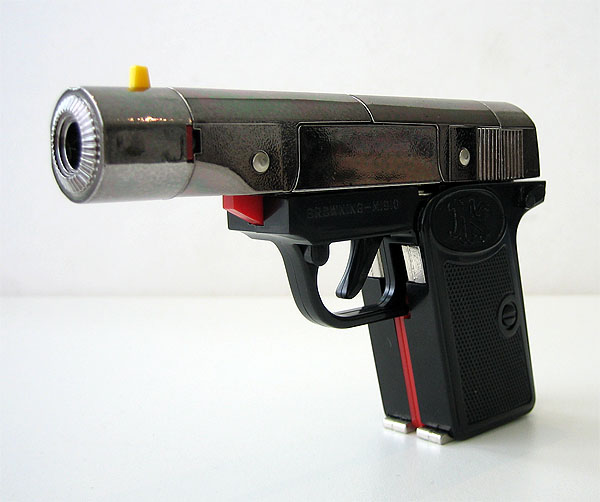
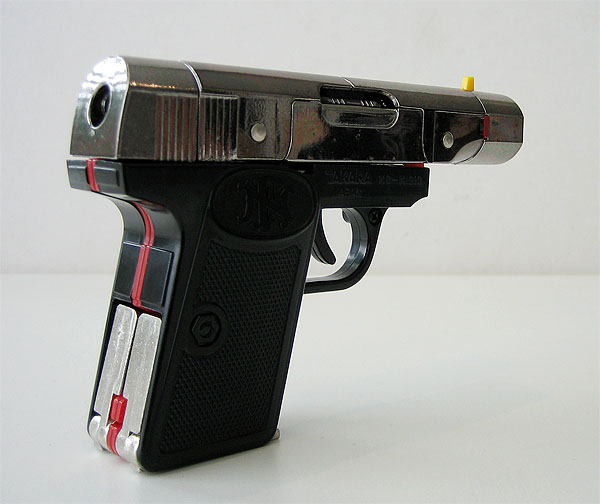
It's a replica of a weapon intended for harmful purposes and some would argue it promotes the glorification of violence and killing. But when viewed as what it was made to be, a marvel of toy engineering that takes an everyday object made to correct scale that transforms into a credible robot, Robocolt is a tremendously elegant example of good proportions, displayability and even now, acceptable realism. It was acceptable when it was released because such things were not taboo in 1983, and it should be acceptable now because none of us collectors are running around our front rooms pretending to shoot anybody.
All of that bullshit aside, Robocolt is simply spectacular in gun mode.
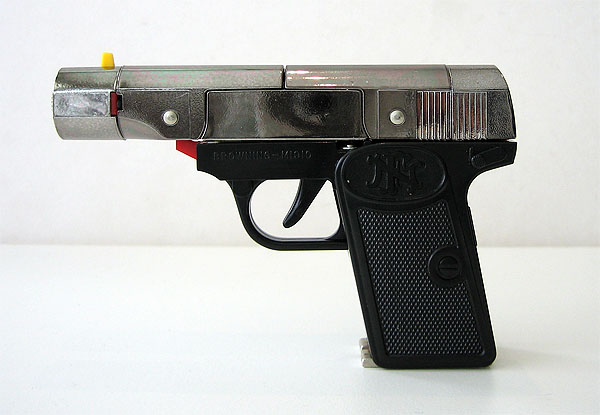
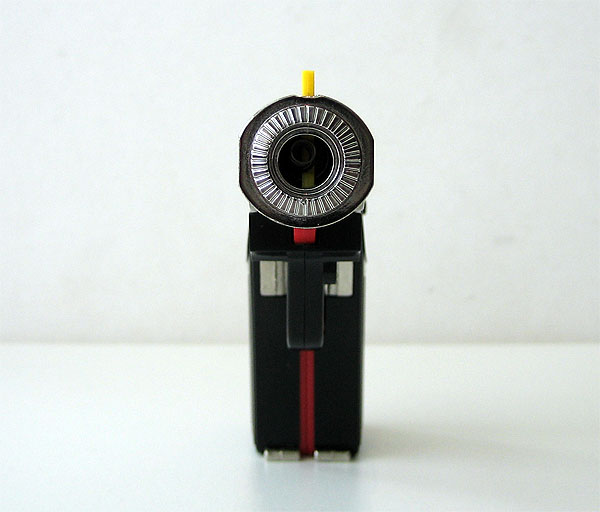
Despite the red and yellow highlights on this particular specimen clearly marking it out as a toy, you cannot help but be impressed by its simple, and I say it again, stylish looks. Robocolt needs no embellishment in the way of stock pieces, faction insignias, stickers or accessories. It's just perfect as it is, but it really does look like it's from another era. The lines are easy on the eye, even the bolts that aid the assembly, transformation and pivoting of moving parts blend into the overall design and appearance seamlessly.
Here he is in blue and rose gold:
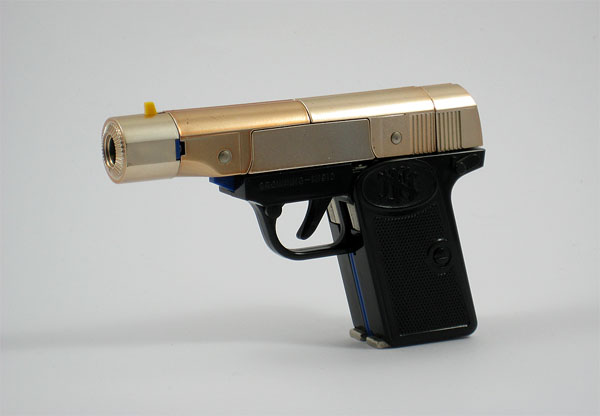
Even though the actual FN model M1910 has a very uniform metallic look, the fact that only Robocolt's top half is chromed and has obvious toy features, there is much accurate detailing.
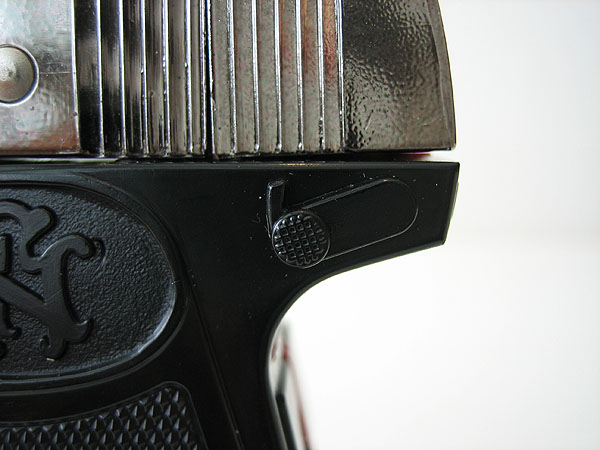
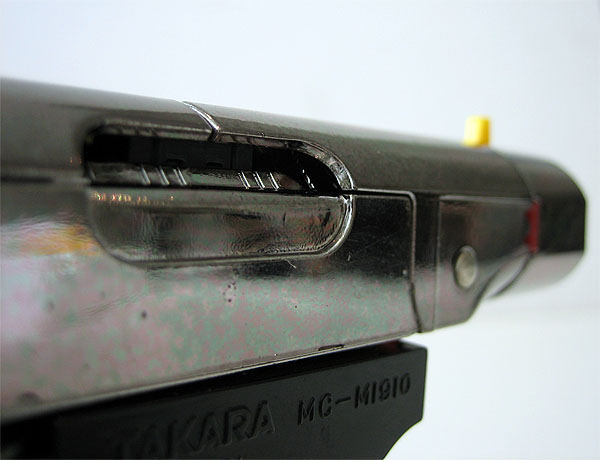
The above shot shows the smokey chrome effect up close, giving this red-type Robocolt and MC-07 Browning a somewhat unique appearance amongst the Micro Change Gun Robos. Below you can see the excellently reproduced and distinctive Fabrique Nationale logo on the handle grip:
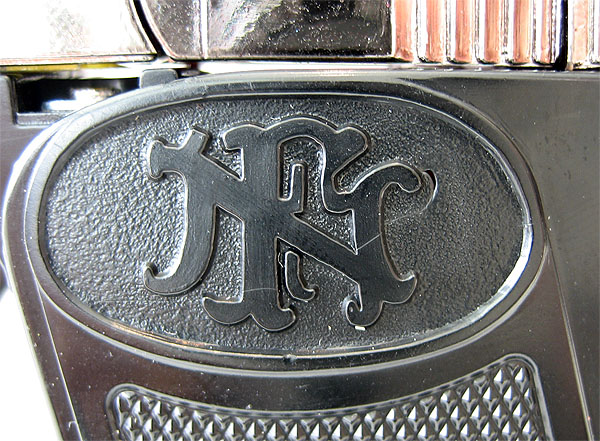
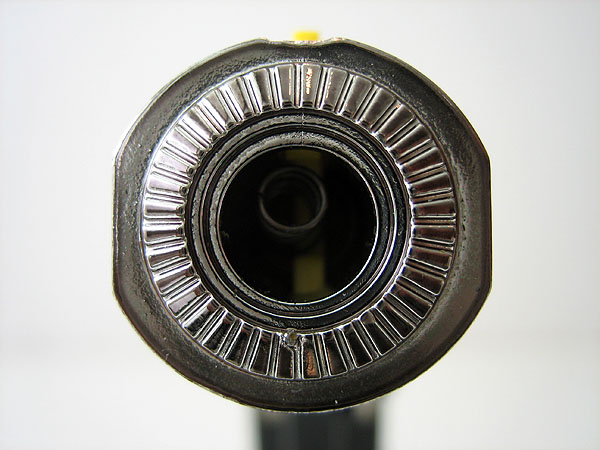
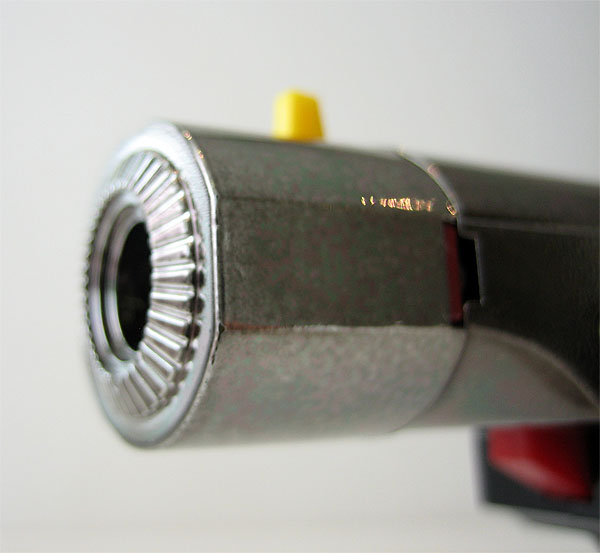
The intricate detailing on the end of the barrel is one of my favourite features of the gun mode and the figure in general. When you know that all the gun mode compromises exist to complement the robot mode, and you realise that none of it is to the overall detriment of said mode, a greater appreciation for the mould can be felt.
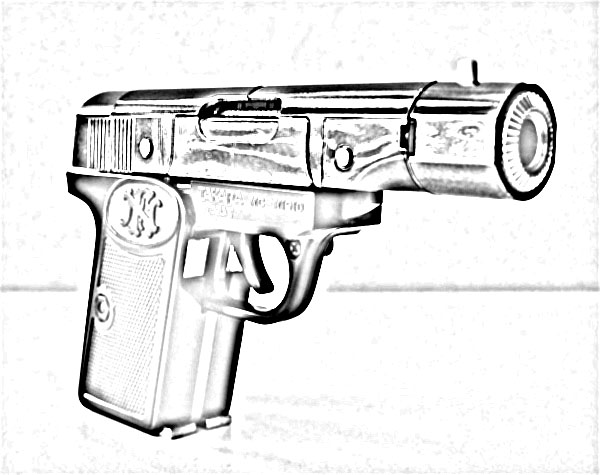
And let us have another look at just how different the red and blue versions of this breathtaking toy look in gun mode:
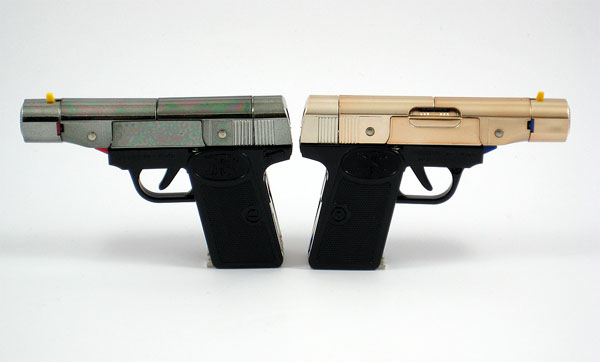
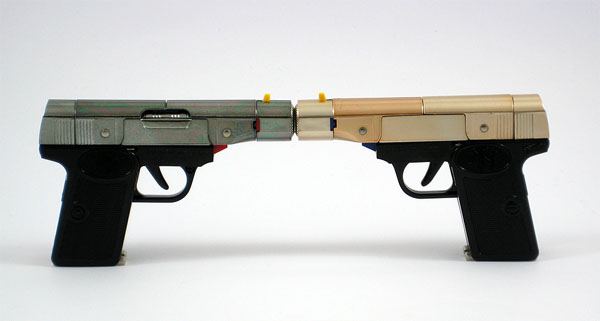
While the superb gun mode qualities are probably enough for most collectors to want such an item in their collection, whichever release they prefer, the robot mode really drives home what an exceptional design Robocolt has.
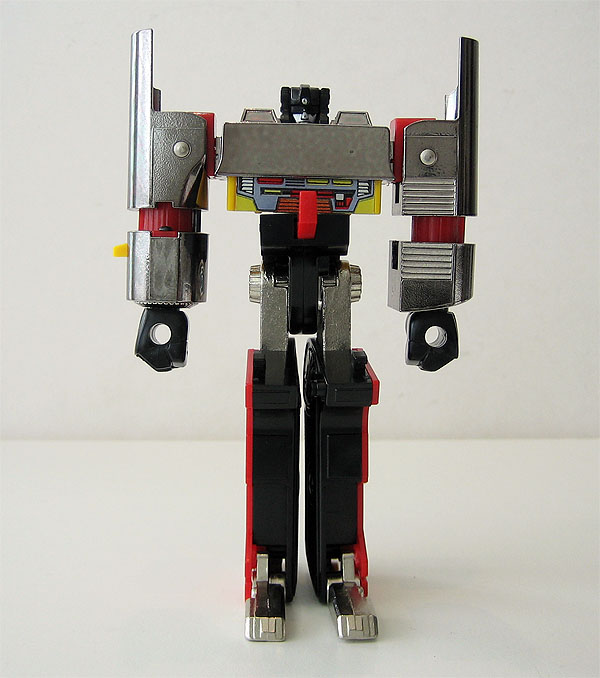
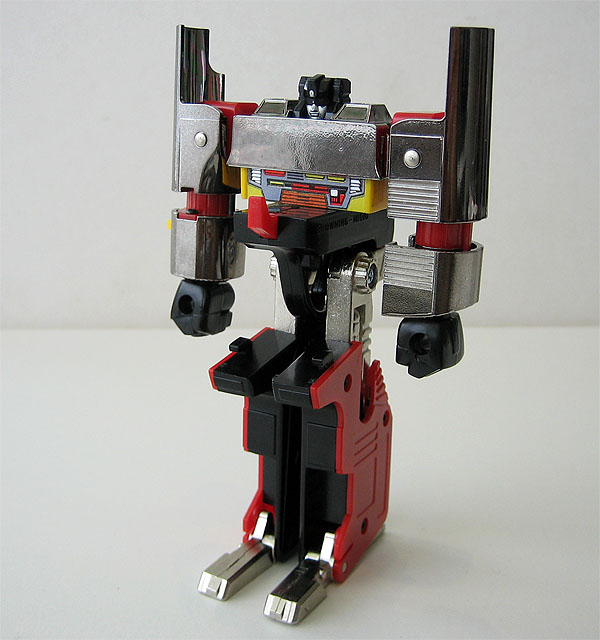
Looking astoundingly stiff, this very basic robot mode configuration is clearly not the strongest display stance for the transformed Robocolt, but even then it shows off the huge proportion of metallic exterior sections, be they chromed plastic or diecast metal. The gigantic beefy arms and oversized feet coupled with the relatively tiny robot head should really be a recipe for disaster, but the overall result is quite the contrary.
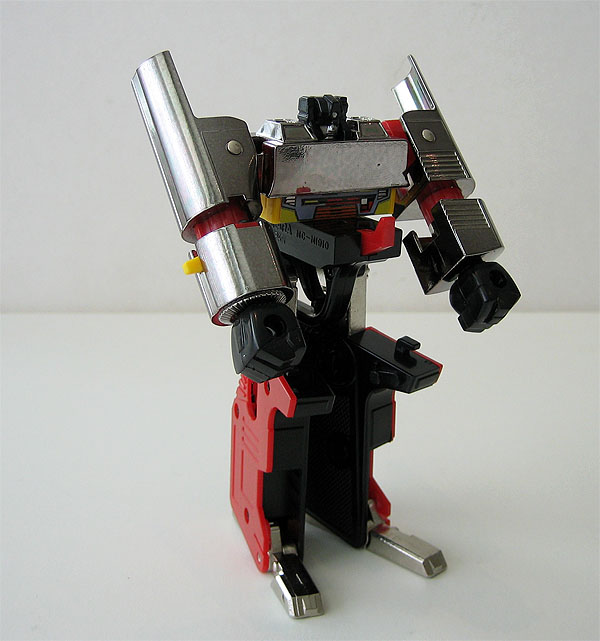
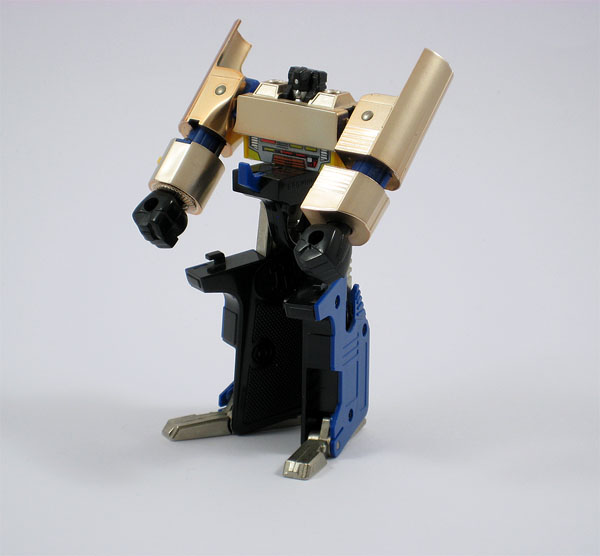
Looking far more animated with his legs, arms and shoulders posed, Robocolt comes to life. A design and colour contrast so successful that even the abdominal factory sticker seems surplus to requirements. How wonderful it would have been had the abdominal section been chromed as it is on Megatron, because currently it is a very fragile yellow plastic piece. You can see both variants of Robocolt as a robot above, and I would say the two are distinct enough to warrant separate purchase. One very nice detail that deserves to be mentioned can be seen in the side profile, the last thumbnail from the above set. You can see a bullet has been moulded into the side of his leg to simulate the working of Robocolt's innards in robot mode, a lovely touch just to help maintain the suspension of disbelief.
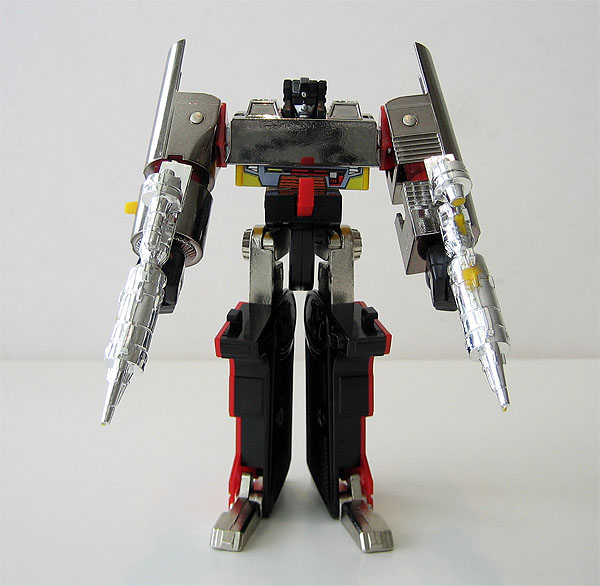
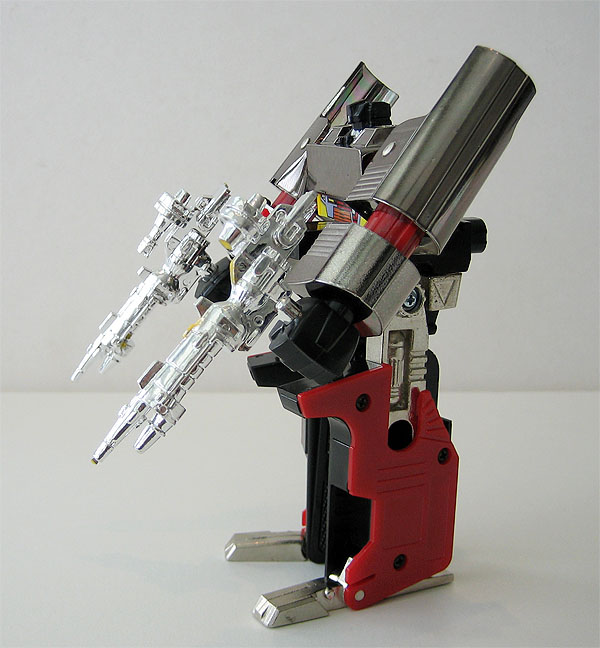
Arming Robocolt with both his handguns instantly introduces more chrome and shine to the picture, as well as immediately highlighting one of the main points of wear for this toy. Besides the broken section on one handgun, any small amount of chrome wear on the guns will reveal bright yellow plastic underneath, but at least it goes with his abdominal piece. As serious as the guns are to look at, with fists like that you could be forgiven for feeling he should have had even bigger weapons! The yellow tab on Robocolt's right arm is for launching the right fist, and explains why the toy comes with more than just two fist pieces.
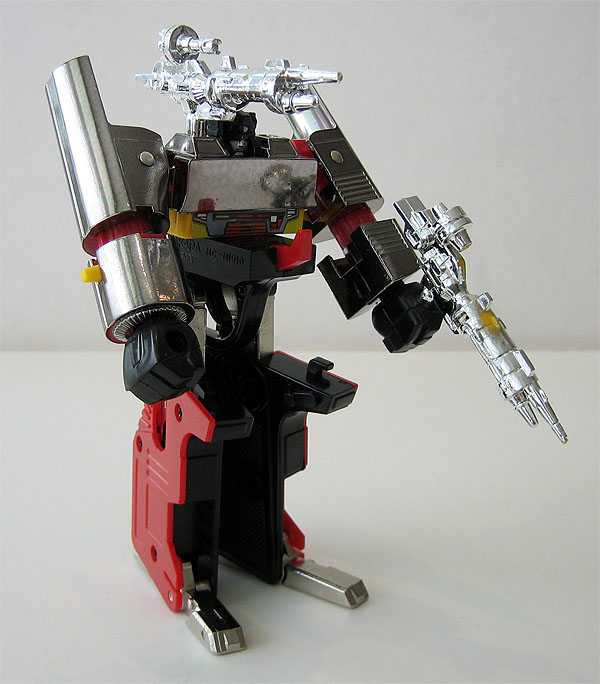
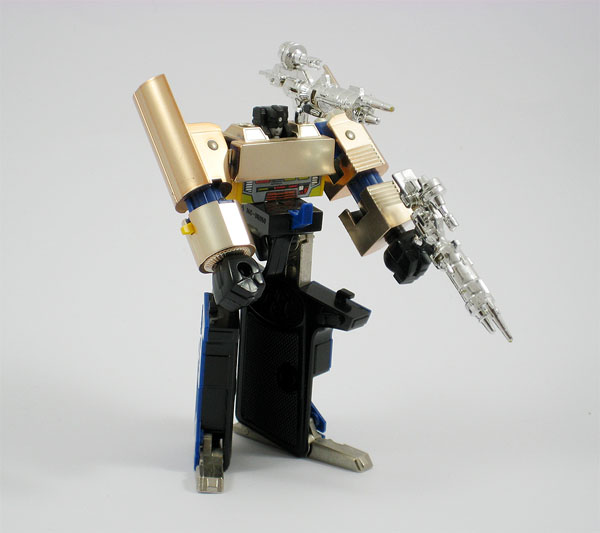
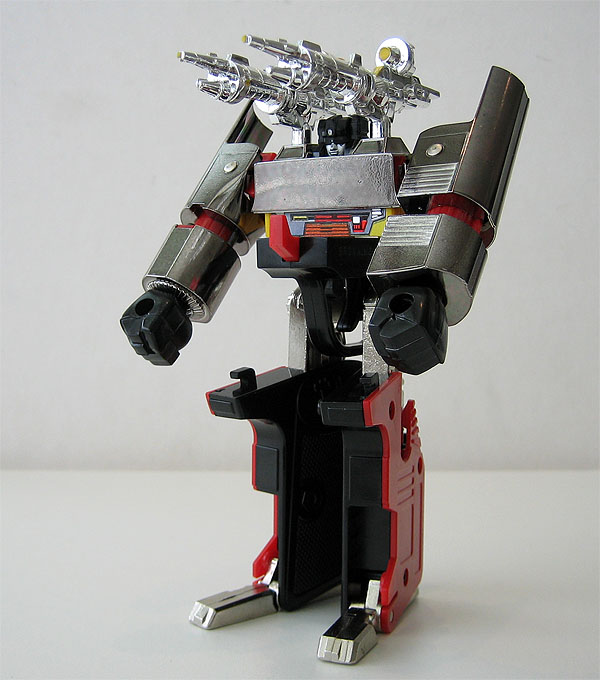
As previously mentioned, the handguns or "Super Lasers" as they're called in chapter 8, can be shoulder mounted in the purpose-made holes. This welcomed variety in displayability means that not only you can give him all manner of poses, it implies that you can free up those beefy fists for quite the robot punch-up! Robocolt, bruiser that he is, continues to maintain considerably more than just a modicum of elegance. The irresistible metallic gleam, the completely justifiable bulk and acceptably strange proportions, Robocolt is so much more than just a gun. Here are a few more shots of Robocolt and his shooters demonstrating what a clean look and finish he has despite the visible pegs here and there, the last picture almost reminiscent of a Fairlady Z Car Robot with door wings and shoulder-mounted rocket launchers:
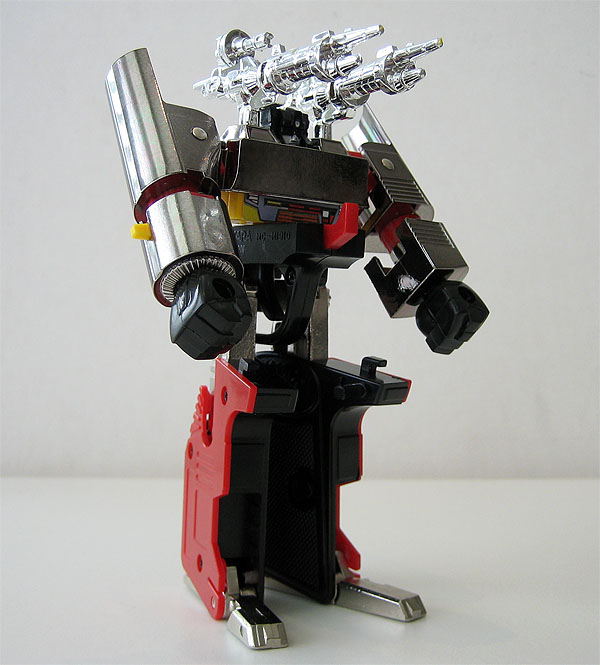
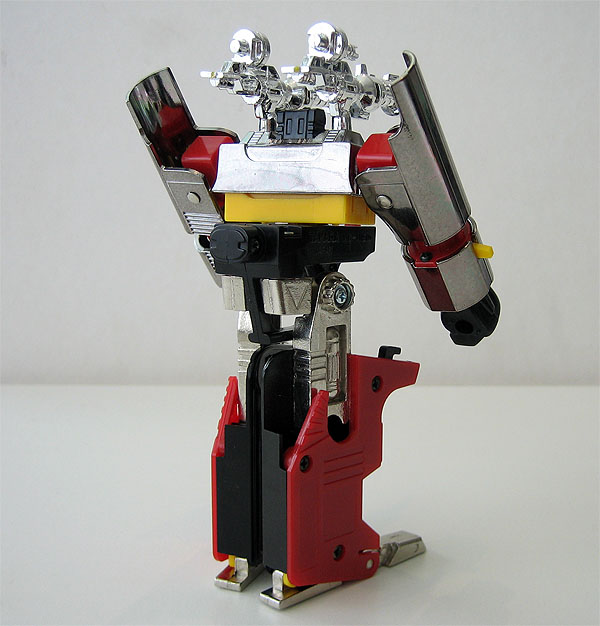
Let us now have a slightly closer look at the standout robot mode features on the Ceji Joustra Diaclone Robocolt:
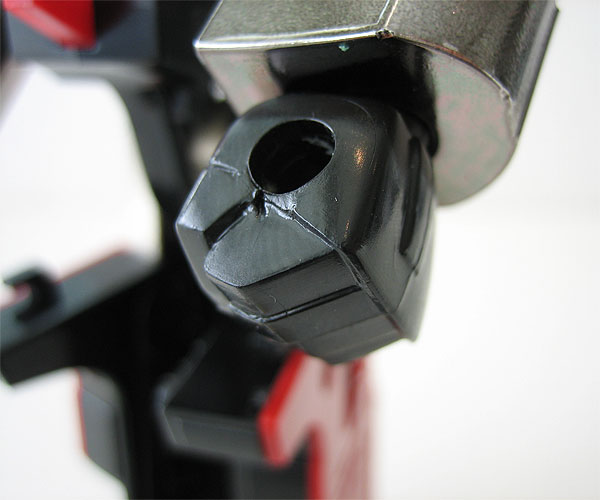
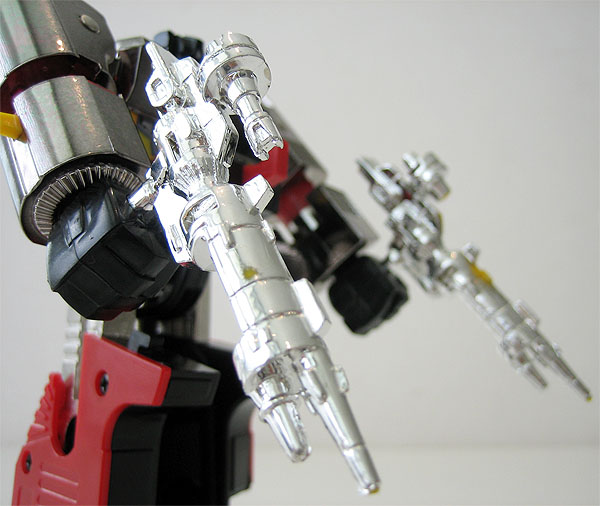
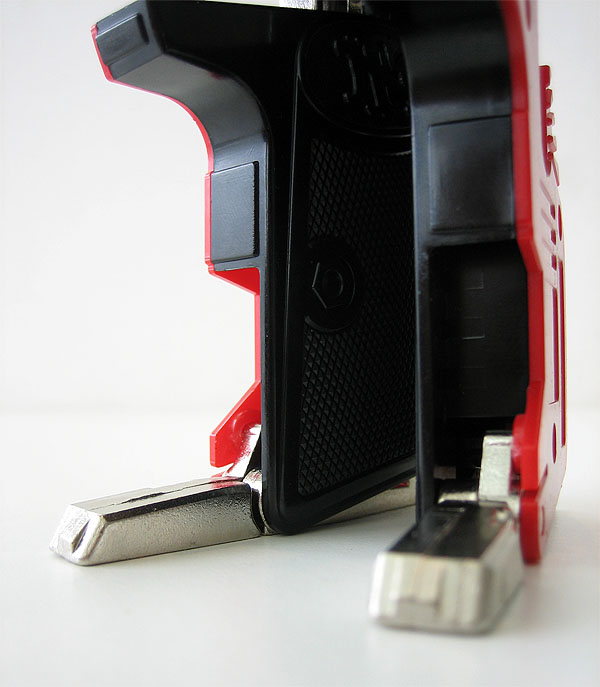
Of particular interest is the robot head sculpt which bears an uncanny resemblance to that of the micro cassette "Frenzy", who was of course originally a Micro Change Series toy as well:
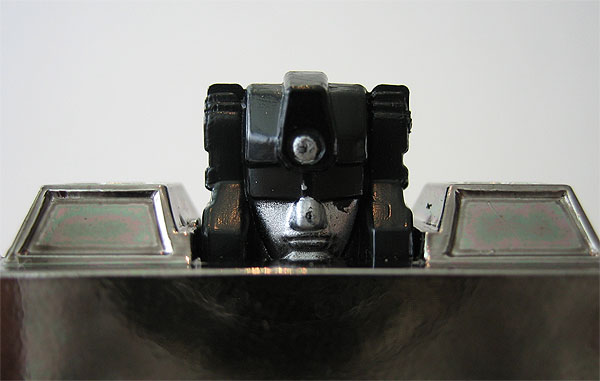
Supporting the theory that Robocolt is a brute-fisted bruiser, his nose appears quite flattened and oft-broken! The paint wear on the face is factory and not due to any wear on what is otherwise a generally unused item.
Let's enjoy the two colours of Robocolt armed and standing back to back:
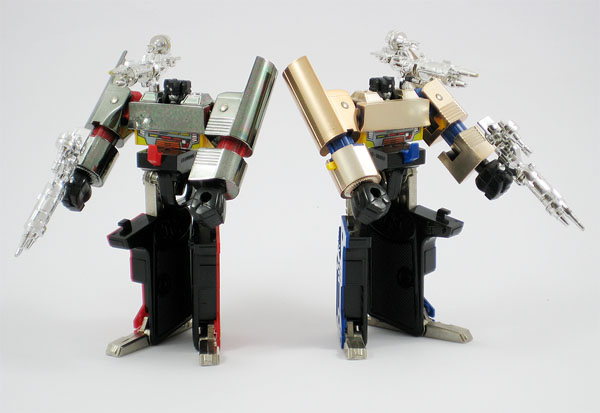
Since we can quite easily imagine his gun mode proportions and size, to give you an idea of the robot's dimensions here is Robocolt alongside some other familiar personalities:
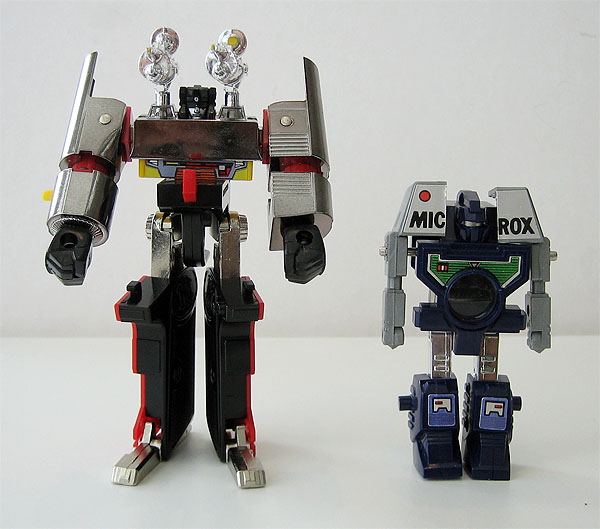
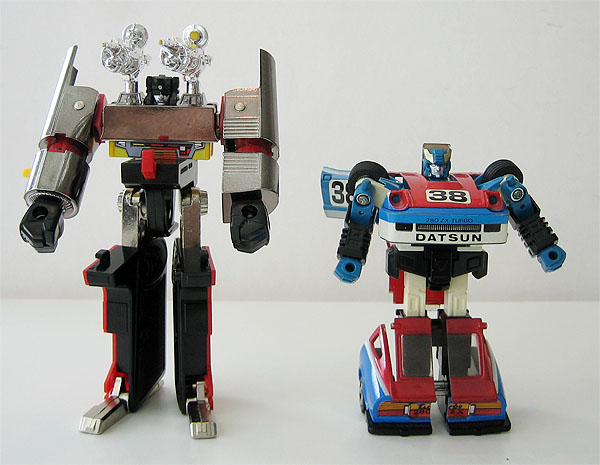
A small pistol he may be, but as far as his robot mode goes Robocolt is not among the smallest of the Diaclone and Micro Change range of figures by any stretch. The significant amount of diecast on his thighs mean that he has a nice weight to him as well. Here he is amongst his own:
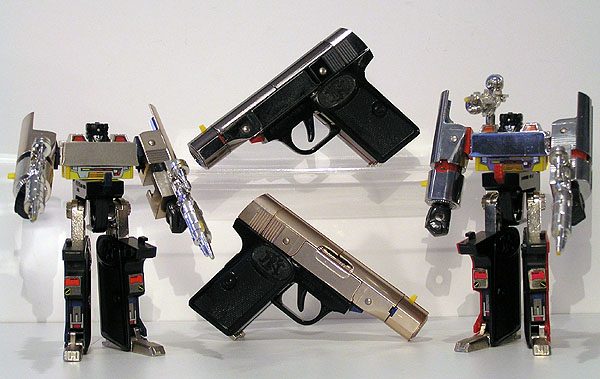
As you would expect for a toy that was not being prepared for introduction to the 1984/5 Hasbro Transformers selection, the moulding and copyright on Robocolt are the same as that on the Japanese Micro Change Series MC-07 Gun Robo Browning:
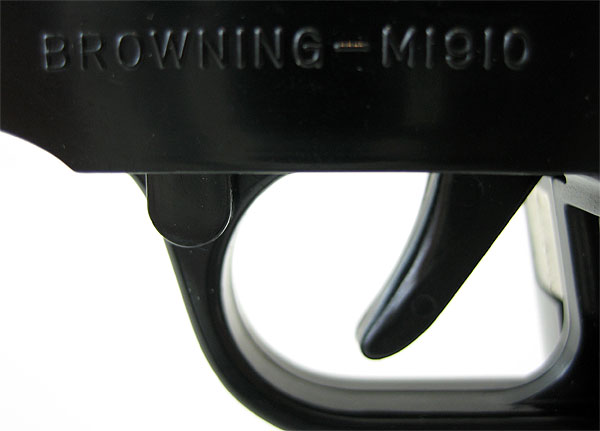
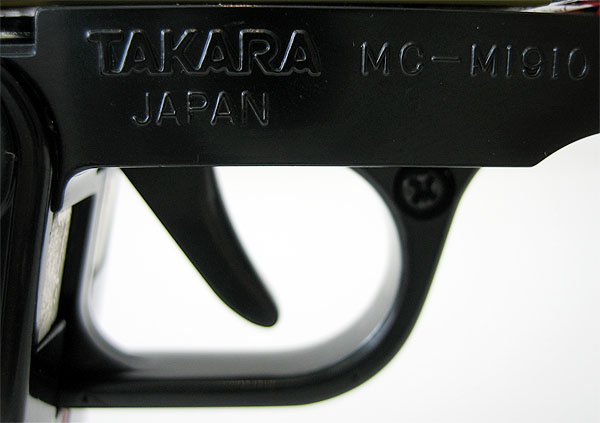
As we approach the final leg of this tour, we can glance upon some of the more far-flung places this design has been used. This is an image of a Micro Change small model kit Browning:
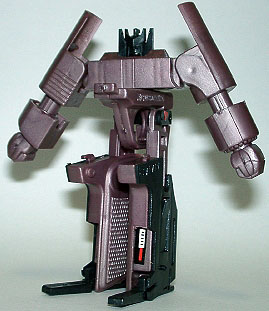
And now a bootleg model kit with artwork that inspires echoes of crybaby-soaked guitar riffs:
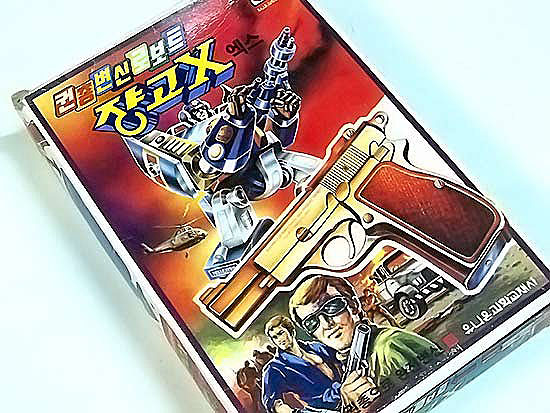
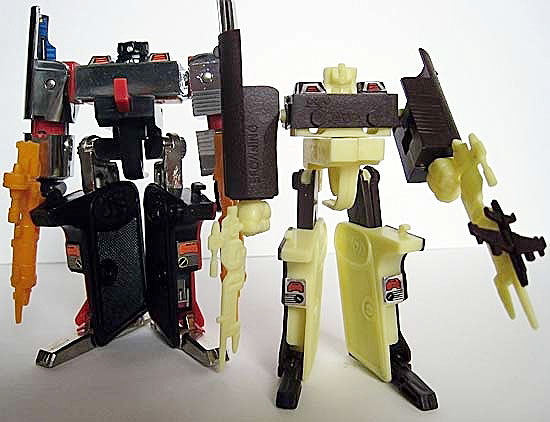
Jon Krause's breathtaking uncropped Browning artwork for this article for which I am eternally grateful:
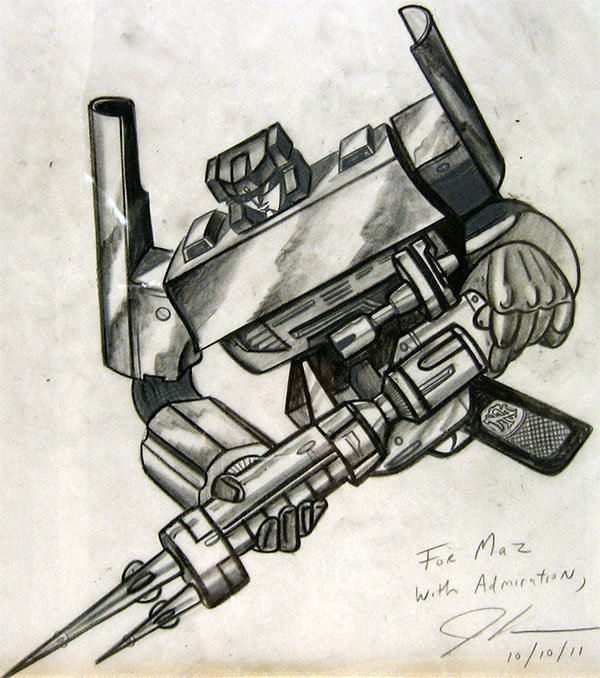
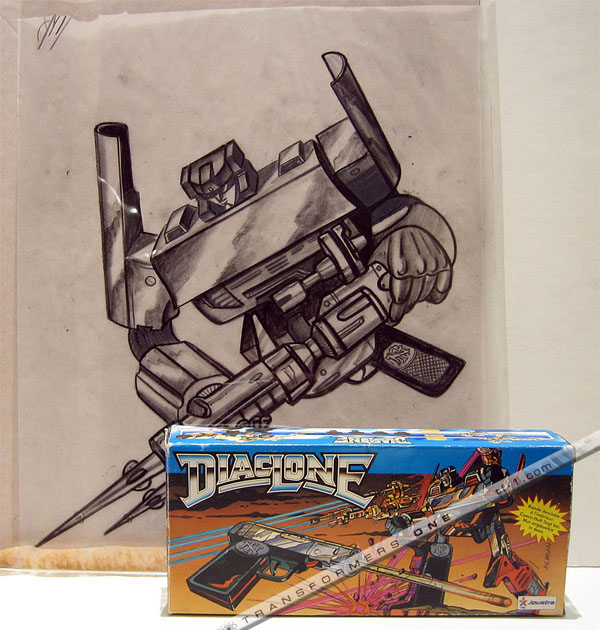
A set of Japanese promotional store give-away Micro Change stickers featuring Browning amongst others:
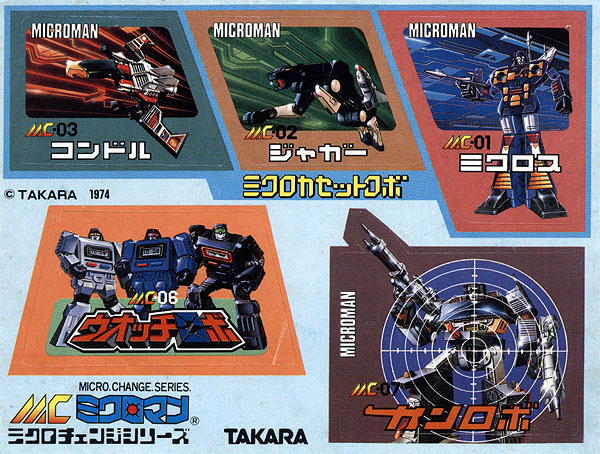
Robocolt amongst the rest of my Ceji Joustra Diaclone collection as of December 2011:
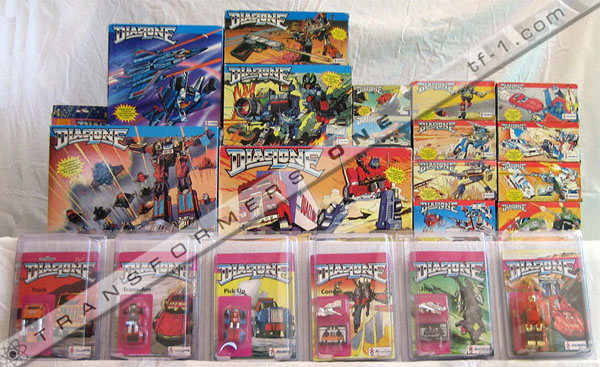
Some screen grabs from Japanese anime series Super God Masterforce, in which "Browning" is a quite comical 1:1 scale tiny Destron companion to Cancer, gifted to him by Lady Mega:
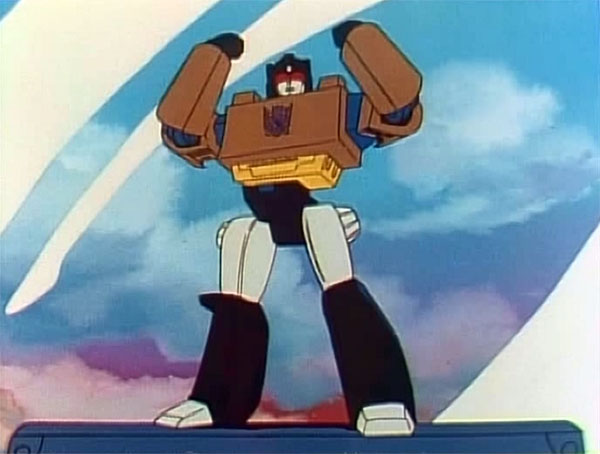
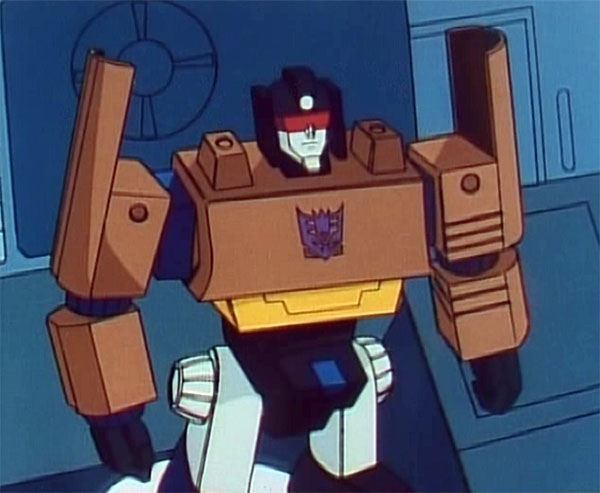
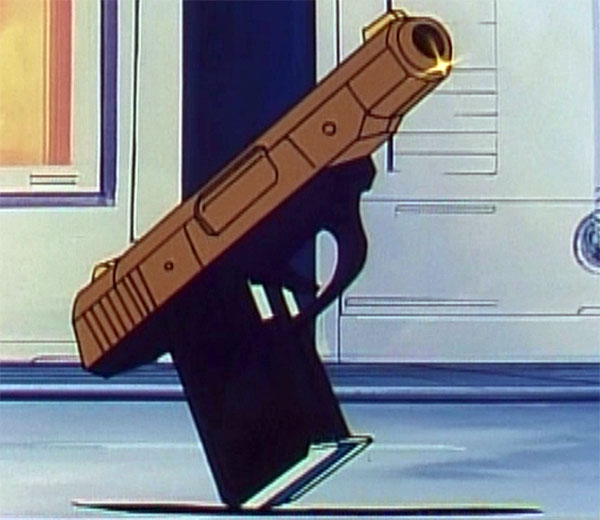
A self-indulgent bunch of black & white photographs of the super-photogenic Robocolt:
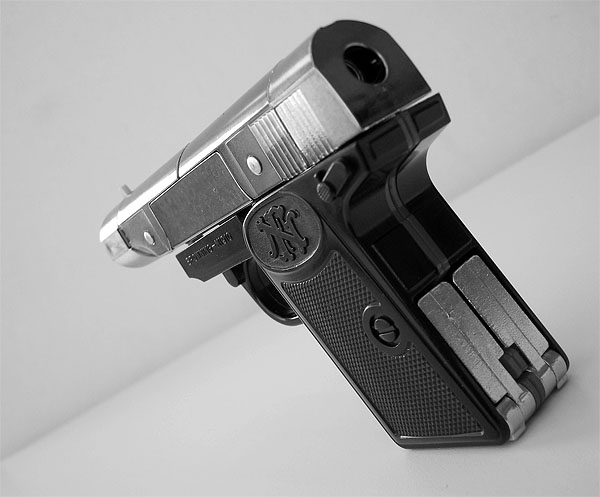
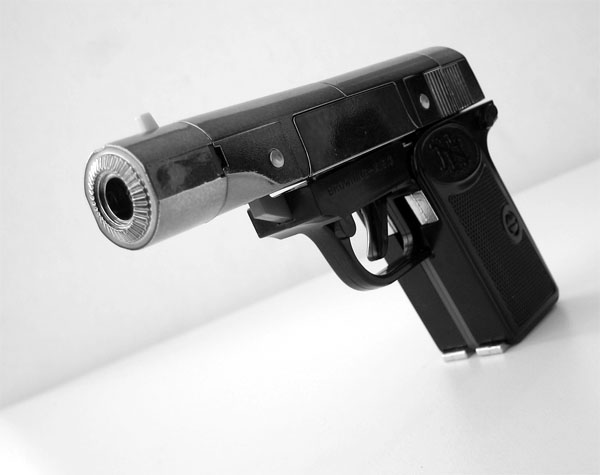
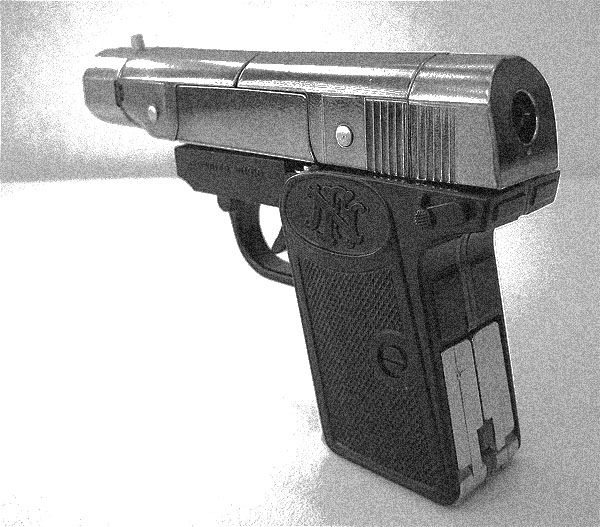
Writing this article and getting the necessary material was not all good times and smiles though, two vintage Joustra Diaclone Robocolts were seriously harmed in the making of this piece. My own one suffered from a broken abdominal/waist section after I neglected to extend the rear section of the pistol before lifting the chest. Some toys need instructions for the forgetful, even Joustra Diaclones!
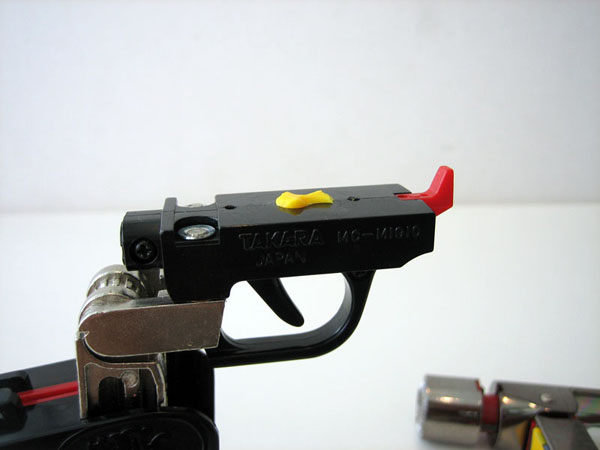
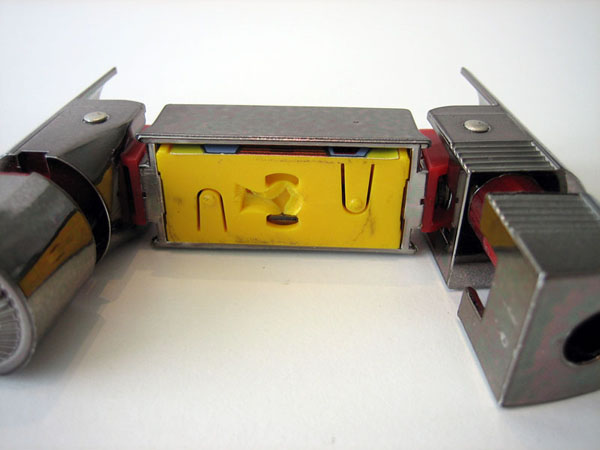
At least I was able to repair my red Robocolt with a substitute Joustra part (from yet another broken specimen!). Poor RpChristophe had a similar moment of heartbreak when his blue Joustra Robocolt suffered from a crack in the blue outer leg plastic having been transformed for the first time, a very common issue with blue Robocolts:
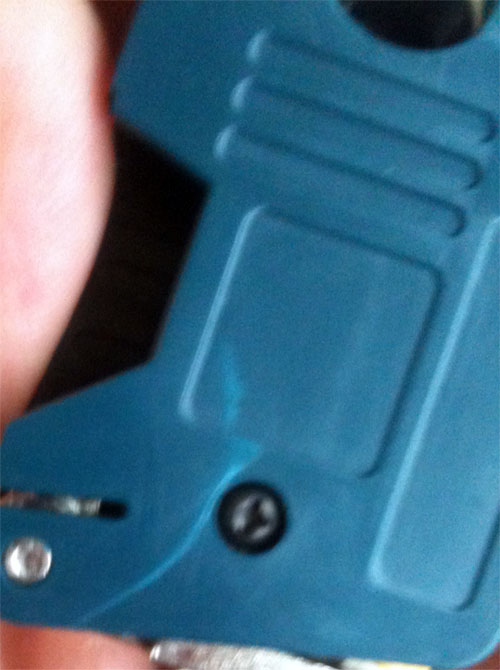
However, I think a toy as beautiful as the Ceji Joustra Diaclone Robocolt, and its predecessor the MC-07 Gun Robo M1910 Browning, deserve this written and visual tribute to their everlasting legacy and greatness to be ended on a positive note. An unforgettable note. To that end, here are some pictures of the most beautiful, special, and elusive version of all the Browning-mould toys, or indeed any Gun Robo, the gold Micro Change campaign prize MC-07 Gun Robo M1910 Browning.
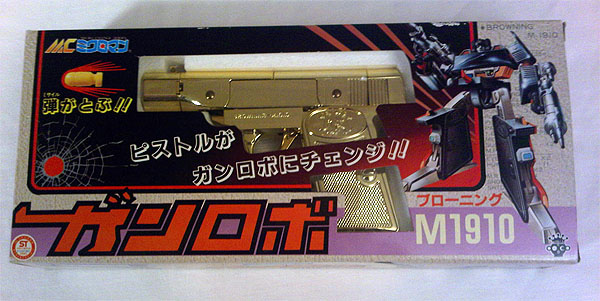
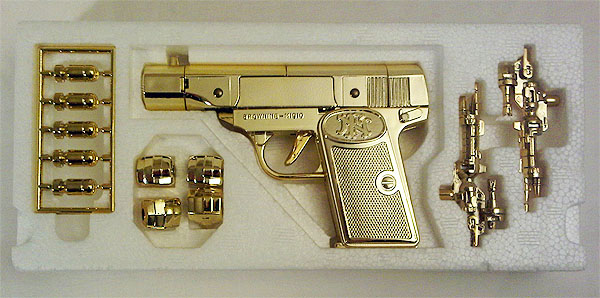
And look at the paperwork, it's another appearance for the very special Micro Change stickers featured earlier. Maybe they weren't just a store giveaway after all...
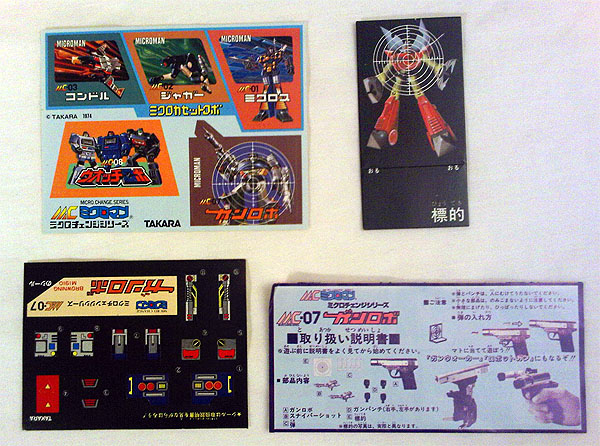
The inherent fragility of 30 year old toys and blue plastic aside, the Robocolt and Browning mould is something no collector should deny themselves. Two fiercely strong modes for display and functionality, a very enjoyable and satisfying (albeit hazardous) transformation process and enough packaging styles to suit everyone's tastes. Of course I am biased towards anything with a bit of flare in the artwork and the Ceji Joustra Diaclone release stands head and shoulders above all other Brownings and all other Gun Robos. The toy itself is so brilliant that it has moved collectors to go and purchase it immediately on first viewing, this happened right before my eyes just recently. The Kingdam Browning bootlegs are amongst the most popular and widely owned KOs because many haven't been able to wait it out for a cheap original, and simply had to own the mould.
The Joustra Diaclone Robocolt is, like all his brethren, much more than just a foreign release of a Micro Change or Diaclone toy in scintillating packaging. It is the first instance of this mould ever receiving a sentient personality and backstory. With an accompanying mini-comic that paints a picture of a cold-hearted murderous traitor, what's not to love? But then, could a robot that transforms into a purpose-built firearam ever have been a good guy? The genuine feeling of darkness and betrayal that comes through the 4 tiny pages of comic strip storytelling and artwork is a tribute to the work of the Brizzis and the genius of Ceji Joustra.
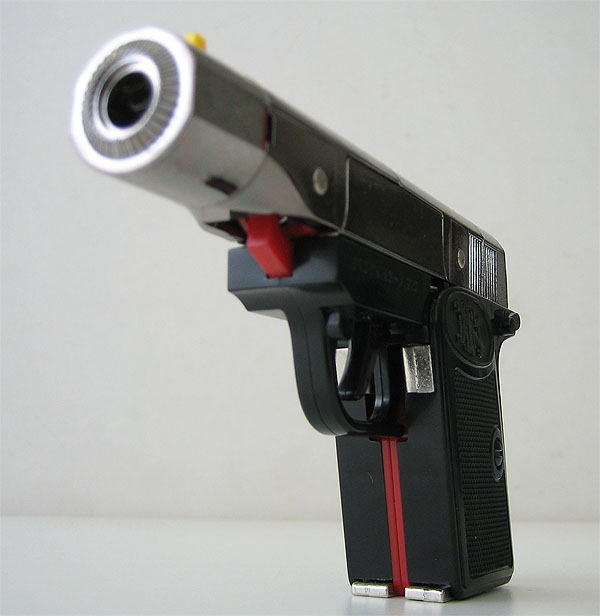
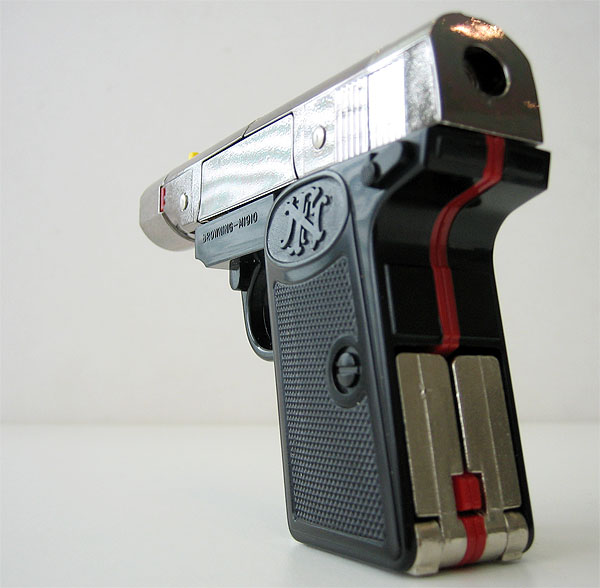
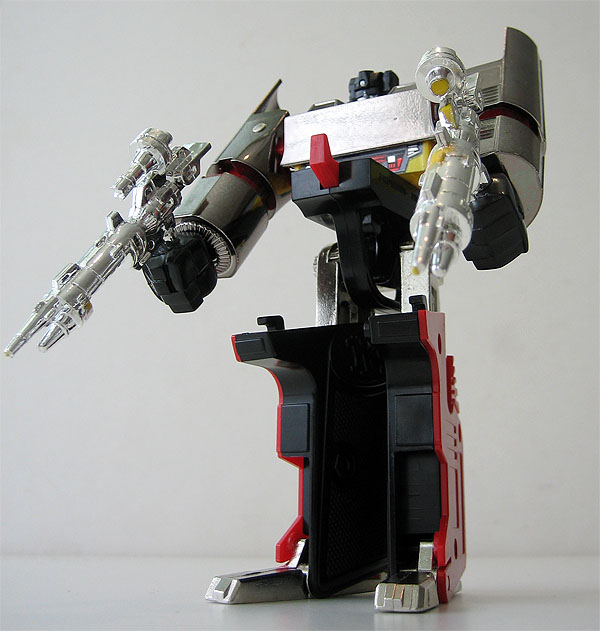
Immense thanks to Quint Gremmen (MC-07, KOs, D-308) and RpChristophe (Joustra) for risking such damage to their collection centrepieces in the name of the cause. Kind thanks to Matteo Pigliucci for the use of his GiG Browning images, to Detour and RpC for translation assistance, to Maxim Popenker (Modern Firearms) for the M1910 image, and anonymous credit to whoever owns the Browning model kit images (please feel free to claim or request removal!), to Ras, Morgan Evans and Vincent Tijbout for their info, to the immeasurable talent of Jon Krause for his artistic contribution and to Mijo for his unending kindness.
All the best
Maz
(maz@tf-1.com)

















